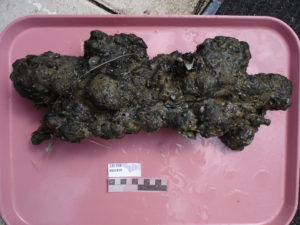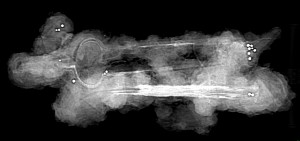When concretions are brought up from the Storm Wreck excavation site, they are documented meticulously. This is to in order to record the location and any possible relation to surrounding artifacts and the site as a whole.
However, unless there are some very telling diagnostics or features, it’s usually very tough to tell what the concretion actually is. For this, we take the concretions to get X-rayed.
A two-legged mystery
Artifact 234 came out of the 2012 LAMP field season.
It was taken to Flagler Hospital to be X-rayed. In the ensuing images, it was possible to see three different types of artifacts. There were small lead birdshot (shown as the bright white dots), an iron spike (the bottom half of the image) and an intriguing two-legged artifact (the top half of the image).
The two-legged object was the item of most interest in the concretion. It was, at first, believed to be a set of dividers, a tool used for measurement. The large size of the artifact and the unique purpose proposed a very intriguing find and something definitely worth conserving. While we have lots of interesting artifacts from the Storm Wreck site, this artifact was one of a kind.
However, in the X-ray, almost no metal shows up. The ghost outline of the object leads one to believe the original material was iron and it had entirely corroded out. Typically when iron objects go down with a shipwreck they begin instantly corroding.
If the artifact is covered up with sediment quickly enough, the corrosion product will bleed through the debris and begin hardening over the surface. This is ideal because the resulting concretion will protect the surface of the artifact and reduce further corrosion by inhibiting exposure to oxygen and oxidation.
Even when the concretion builds up fully around the artifact, it will sometimes not be enough to save the item inside. Some iron, most notably wrought iron, will continue to bleed and corrode until all the metal disappears.
The X-ray of the two-legged object showed a minimal radio signature and no metal left. Because of this, I planned to use the void left by the disappearing iron to my advantage.
An unexpected surprise
Instead of removing all the exterior concretion like a typical artifact, I would instead try to leave a thin layer around the original exterior of the object. I would then puncture the concretion to create a few holes throughout the void of the artifact. These holes would allow me to scrape out any remaining metal and pour epoxy in.
When the epoxy cures, the result should be a cast replica of the original artifact; effectively getting something out of nothing.
While removing the concretion, though, I came upon something unexpected. Much of the iron still remained.
Even though it did not send back a good X-ray image, the metal was still firm enough to maintain the artifact’s shape. After airscribing along the edge of the artifact I was also able to better determine what it was.
So what is the two-legged object?
At this time, the best possible explanation is that it is a pair of cast iron fire tongs. There appear to be a few spots that need to be cleaned out and filled with epoxy, but overall the condition is good.
This artifact is a great example of why we use X-rays before beginning any conservation work, but also why they are not the perfect tool for diagnosing artifacts. The X-rays allowed us to see that it was a unique item and worthwhile to add to the assemblage of the collection. However, the X-rays also showed that it might not have been worth the necessary conservation because none of the original material remained.
Learn more about Storm Wreck
- Click here to find out more about the Storm Wreck, a 1782 British Loyalist shipwreck found off St. Augustine’s coast by lighthouse archaeologists.
- Click here to learn more about the development of our new Storm Wreck exhibit, which will be unveiled in Spring 2016.
- You can also see more about the ongoing conservation of hundreds of artifacts recovered from this shipwreck right here on our lighthouse blog.
Andrew Thomson is the Assistant Conservator for the St. Augustine Lighthouse & Museum. He received his graduate degree and training from the Conservation Research Laboratory at Texas A&M.





